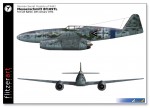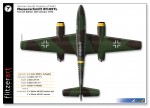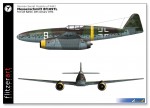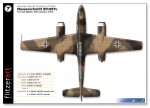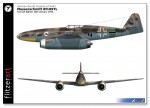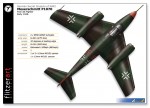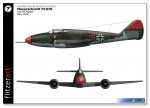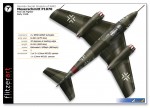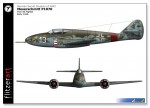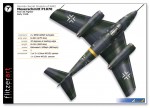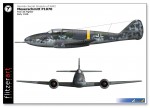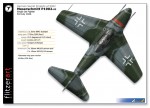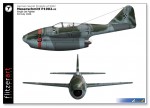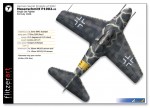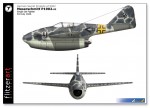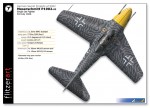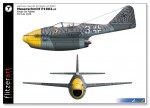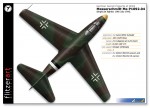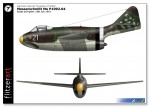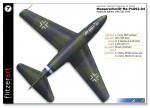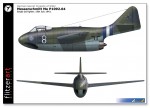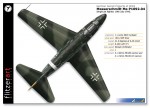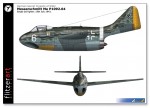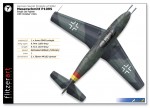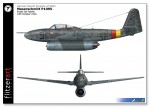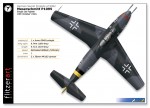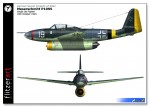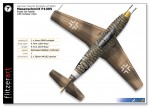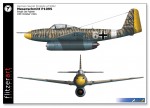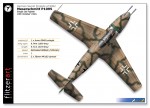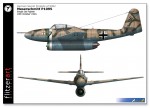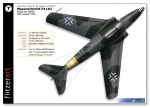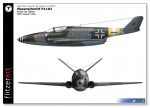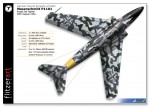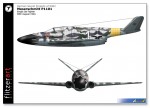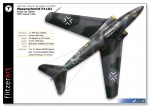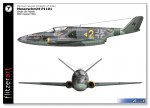German Secret Projects of WW2 Volume 8
6
Comments
Messerschmitt Bf109TL
The Messerschmitt 109 Turbo-Lader Strahltriebwerk (turbocharger jet engine) was proposed on January 22, 1943 at an RLM conference as a back-up for the Me 262, of which only three prototypes had been completed at the time. In order to cut down on design and production time, various components from existing aircraft were to be used. These included the fuselage from the Me 155B high-altitude fighter (with a new nose and tail section), the wing from the Me 409 project and the undercarriage from the Me 309. The armament was to be two MG 151/20 20mm cannon (120 rounds each) and two MK 103 30mm cannon, all in the nose. A later proposal included two MK 108 30mm cannon could be installed in the wing roots. The performance was estimated to be better than the Me 262 due to the Me 109 TL's narrower fuselage. Following intensive study, by March 1943 it was decided that so many modifications to the various components would be needed that no time would be gained over the Me 262 development, thus the project was abandoned.
Messerschmitt P1070
The Me P1070 project ran side by side with the P1065, which evolved into the Me262, and served as an alternative study. In fact certain features such as the structure of the wings and the nose wheel design were later incorporated into the definitive Me262.
The P1070 was smaller and more compact by an appreciable amount over the Me262 and was an exercise in how small a twin jet fighter could be. For example the engine fairings where mounted mid wing and would be described today as ‘shrink-wrapped’ as they were as tightly fitting as was possible. At the time the Me 262 was already under construction and the production costs would not have made any economical savings.
It did, however, answer much of the RLM findings with the Me262 which in spite of being enthusiastic about it did issue a statement, even before it went into service, saying that if the allies used jet powered fighters, the advantage would be lost and on any future designs it would be preferred if the wings were more swept and the engines not simply hung from beneath the wings as this causes drag and therefore is detrimental to outright performance.
Messerschmitt P1092.02
In mid 1943, Messerschmitt picked up on the earlier P1092A design, continuing with a further series of small, single-seat, single-jet fighters. The design team, was led by Hans Hornung along with Woldemar Voigt and Willie Messerschmitt himself was directly involved. The design illustrated here is the P1092.02 and showed a changed overall look.
The cockpit was placed midway along the short and dumpy fuselage The wings were mounted mid-fuselage, with slight dihedral and were swept back at 21.5 degrees. The design also made provision for an extended wing version. A conventional tail unit was designed, and was mounted on a boom over the single Jumo 004C (1015 kg, 2237 lbs thrust). The single fin and rudder with tail unit, with high mounted tail planes, resembled that of the Messerschmitt Me 262. The landing gear arrangement was of a tricycle type, with the main gear retracting inwards, and the forward gear retracted to the rear.
For a small fighter the armament was quite heavy; consisting of two MK 103 30mm cannon, the barrels of which protruded from the fuselage and two MG 151/15 15mm cannon. All guns were mounted in the forward fuselage on either side of the air intake.
The P.1092/2 was adjudged as being superior in almost all competitors in this category. The Me P.1092/2 was not constructed, but it did provide useful experience and design knowledge, that was incorporated into the later designs such as the P1106 and P1101.
Messerschmitt P1092.04
The Me P.1092.04 design further refined the series. The fuselage was similar to that of the Me P1092.03 but the cockpit was moved to the extreme forward fuselage affording the pilot a superior view. The wing was swept back at 18 degrees and the wing, tail and control systems were mostly borrowed from the Me 262 design. As with the P1092.03 the air intake was divided into two ‘nostrils’, located beneath the nose, feeding the single Jumo 004C jet engine. Although the cockpit filled up much of the space in the nose, there was still room for the four MK108 30mm cannon housed further aft on the fuselage sides.
Messerschmitt P1095
Based on previous work on the Me P1092 series and the Me 328 design and prototype, Dipl-Ing Rudolf Seitz led the design team for the P.1095, deciding to use as many existing components from other aircraft as possible, to cut down the development and retooling time.
The first P.1095 design of October 1943 was proposed in two versions. One was to use the entire Me 262 tail unit (horizontal tail and fin/rudder) along with a wooden wing, the other used the entire Me 328 tail unit (horizontal tail and fin/rudder) along with a slightly smaller all metal wing.
The two different P.1095 versions used the same fuselage, including a 200-liter (53 gallon) fuel tank between the nose and cockpit, and two 590-liter (156 gallon) fuel tanks directly aft of the pilot. The power was by a single Jumo 004B jet engine, located below the fuselage. This had the advantage of being easily serviced, but the had the potential problem of possible ingestion of foreign matter into the intake on takeoff.
The version illustrated here however is of an additional third design from October 19, 1943 for the Me P.1095, which had an overall different shaped with slightly swept wings, but most details have not survived.
The P.1095 project was discontinued in early 1944, due to the fact that the engine location was felt to be disadvantageous, and the performance was less than the Me262 twin jet fighter, which was about to come into service.
Messerschmitt P1101
On July 15, 1944, the RLM requested Germany's aircraft manufacturers to propose designs for the "Emergency Fighter Competition". The specified requirements (and these later changed many times) for the a second-generation jet-powered fighters was: Powered to be provided by a single Heinkel-Hirth He S 011 turbojet Performance to be level speed of 1000 km/h (621 mph) at 7000 meters (22966 feet) Fuel capacity to be of 1000 liters (264 gallons), Operate at altitudes of 14000 meters (45931 feet) Armament of four MK 108 30mm cannon
Engineer Hans Hornung, of Messerschmitt, began to create the first of the Me P.1101 single-seat, single jet engine fighter designs. Only nine days after the specification was issued by the RLM (July 24, 1944), the first Me P.1101 had taken shape on paper. The fuselage was short and wide, with two round air intakes on either side of the cockpit, which fed the single He S 011 jet engine, which was located in the lower rear fuselage. 710 liters (188 gallons) of fuel could be contained above and below the turbojet. The wings featured two different sweepback angles, a steeper angle (40 degrees) near the fuselage and a shallower angle (26 degrees) outboard. Flaps were located over the entire trailing edge to aid in slow speed operations. Another 170 liters (45 gallons) of fuel could be carried in wing tanks located in each of the inner wing sections, making a total of 1050 liters (277 gallons). The V-tail unit (110 degrees of separation) was mounted on a boom that extended above the jet exhaust, a feature that would be present on all future Me P.1101 designs. A steel plate was used on the underside of the tail boom, to protect the enclosed radio equipment from engine exhaust heat. The nose wheel of the tricycle landing gear retracted to the rear and the two main wheels retracted forwards into the wing roots. A single SC 500 bomb could be carried partially stowed in a belly recess. The main armament was to consist of two MK 108 30mm cannon, located in the lower forward fuselage sides.
The second Me P.1101 design followed, dated August 30, 1944 and was basically similar to the first design, but sleeker. The fuselage had a more pointed nose section, and was designed to hold a variety of armament. As in the first design, two circular air intakes, located on either side of the cockpit, fed the single He S 011 jet engine, which was located in the rear fuselage. There were two protected fuel tanks above the engine and behind the cockpit. The wing was "borrowed" from the Me 262 outer wing, was swept back at 40 degrees and mounted mid-fuselage. A V-tail was also to be fitted on this design, with the jet engine exhausting below the tail boom. The nose wheel retracted to the rear and rotated 90 degrees to lie flat beneath the weapons bay in the nose. Both main wheels retracted inwards towards the wing roots.
Provisions were made for a drop tank, and even for a towed fuel tank using the V-1 wing! The armament was to be either a MK 112 55mm cannon or two MK 108 30mm cannons, with a possible third MK 108 or MK 103 30mm cannon being able to be squeezed in. One of the more advanced weapon proposals for this design variant of the Me P.1101 was for the upward firing SG 500 "Jagdfaust" (Fighter's Fist). This was basically a thin cased 50mm high explosive rocket propelled shell housed in a vertical tube. Two of these would have been placed in the fuselage nose, and a single SC 500 bomb could also be carried beneath the fuselage.
After obtaining many differing results from a variety of wing profiles and fuselage shapes from wind tunnel testing, Messerschmitt produced a third version of the P1101. This design moved the cockpit up and over the intake and jet engine. And since many of the components were already built (wing assembly, undercarriage, engine and controls), Messerschmitt decided to actually build a full-scale, as it was felt that the aircraft could be flying and giving more accurate test results in a relatively short time.
There was no official backing from the RLM of Luftwaffe High Command for the construction of this test aircraft. Despite delays due to the worsening war situation and transportation of some of the components, construction slowly took place at Messerschmitt's Oberammergau complex in the Bavarian mountains of southern Germany. This complex was unknown to the Allies, and did not suffer any bombing raids during the war. It was intended to begin test flights with the wing sweep set at 35 degrees, and later to try a 45 degree sweep, since the wing was designed to be set at different sweepback angles while on the ground. The first test flight was to take place in June 1945.
The Me P.1101 V1 was about 80% complete when the complex was discovered by American troops on April 29, 1945, a few days before the war's end.
The Me P.1101 V1 was subsequently shipped to the Bell Aircraft Works in Buffalo, New York in August 1948. More damage was sustained when the aircraft fell off a freight car, which in effect ruled out any possibility for repair and flight testing. The P.1101 was fitted with an Allison J-35 jet engine, and mock-up weapons (6 x Mg 151 and 4 x MK 108 cannon) were pasted on the fuselage sides. Bell used the Me P.1101 as the basis for the X-5, during which individual parts of the P.1101 were used for static testing. Sometime in the early 1950s, the remainder of the Messerschmitt Me P.1101 V1 was sent to the scrap yard, thus ending this unique and distinctive aircraft's history.
Text based on extracts kindly provided by Dan Johnson of Luft46.com
Websites
www.luft46.com
www.secretprojects.co.uk
(Unfortunately Michael Riener’s www.ww2aircraftprofiles site has sadly been closed down due to contractual and copyright issues.)
Books
Luftwaffe Secret Projects: Fighters 1939-1945 by Walter Schick and Ingolf Meyer,
Luftwaffe Secret Projects: Strategic Bombers 1935-1945 by Dieter Herwig and Heinz Rode.
Luftwaffe Secret Projects, Volume 3: Ground Attack & Special Purpose Aircraft by Dieter Herwig and Heinz Rode.
Jet Planes of the Third Reich Vols 1 and 2 by Manfred Griel
Reichdreams Dossier No 18 Lippisch and Messerschmitt Supersonic Projects by J. Miranda & P. Mercado
Secret Aircraft Designs of the Third Reich by David Myhra
Special Thanks
Special thanks to Dan Johnson of www.luft46.com, members of www.secretprojects.co.uk for advice and data and our very own Rowan (Merlin).
Many thanks. More coming. I’m hoping to include some bombers in Volume 9.
The Messerschmitt 109 Turbo-Lader Strahltriebwerk (turbocharger jet engine) was proposed on January 22, 1943 at an RLM conference as a back-up for the Me 262, of which only three prototypes had been completed at the time. In order to cut down on design and production time, various components from existing aircraft were to be used. These included the fuselage from the Me 155B high-altitude fighter (with a new nose and tail section), the wing from the Me 409 project and the undercarriage from the Me 309. The armament was to be two MG 151/20 20mm cannon (120 rounds each) and two MK 103 30mm cannon, all in the nose. A later proposal included two MK 108 30mm cannon could be installed in the wing roots. The performance was estimated to be better than the Me 262 due to the Me 109 TL's narrower fuselage. Following intensive study, by March 1943 it was decided that so many modifications to the various components would be needed that no time would be gained over the Me 262 development, thus the project was abandoned.
Messerschmitt P1070
The Me P1070 project ran side by side with the P1065, which evolved into the Me262, and served as an alternative study. In fact certain features such as the structure of the wings and the nose wheel design were later incorporated into the definitive Me262.
The P1070 was smaller and more compact by an appreciable amount over the Me262 and was an exercise in how small a twin jet fighter could be. For example the engine fairings where mounted mid wing and would be described today as ‘shrink-wrapped’ as they were as tightly fitting as was possible. At the time the Me 262 was already under construction and the production costs would not have made any economical savings.
It did, however, answer much of the RLM findings with the Me262 which in spite of being enthusiastic about it did issue a statement, even before it went into service, saying that if the allies used jet powered fighters, the advantage would be lost and on any future designs it would be preferred if the wings were more swept and the engines not simply hung from beneath the wings as this causes drag and therefore is detrimental to outright performance.
Messerschmitt P1092.02
In mid 1943, Messerschmitt picked up on the earlier P1092A design, continuing with a further series of small, single-seat, single-jet fighters. The design team, was led by Hans Hornung along with Woldemar Voigt and Willie Messerschmitt himself was directly involved. The design illustrated here is the P1092.02 and showed a changed overall look.
The cockpit was placed midway along the short and dumpy fuselage The wings were mounted mid-fuselage, with slight dihedral and were swept back at 21.5 degrees. The design also made provision for an extended wing version. A conventional tail unit was designed, and was mounted on a boom over the single Jumo 004C (1015 kg, 2237 lbs thrust). The single fin and rudder with tail unit, with high mounted tail planes, resembled that of the Messerschmitt Me 262. The landing gear arrangement was of a tricycle type, with the main gear retracting inwards, and the forward gear retracted to the rear.
For a small fighter the armament was quite heavy; consisting of two MK 103 30mm cannon, the barrels of which protruded from the fuselage and two MG 151/15 15mm cannon. All guns were mounted in the forward fuselage on either side of the air intake.
The P.1092/2 was adjudged as being superior in almost all competitors in this category. The Me P.1092/2 was not constructed, but it did provide useful experience and design knowledge, that was incorporated into the later designs such as the P1106 and P1101.
Messerschmitt P1092.04
The Me P.1092.04 design further refined the series. The fuselage was similar to that of the Me P1092.03 but the cockpit was moved to the extreme forward fuselage affording the pilot a superior view. The wing was swept back at 18 degrees and the wing, tail and control systems were mostly borrowed from the Me 262 design. As with the P1092.03 the air intake was divided into two ‘nostrils’, located beneath the nose, feeding the single Jumo 004C jet engine. Although the cockpit filled up much of the space in the nose, there was still room for the four MK108 30mm cannon housed further aft on the fuselage sides.
Messerschmitt P1095
Based on previous work on the Me P1092 series and the Me 328 design and prototype, Dipl-Ing Rudolf Seitz led the design team for the P.1095, deciding to use as many existing components from other aircraft as possible, to cut down the development and retooling time.
The first P.1095 design of October 1943 was proposed in two versions. One was to use the entire Me 262 tail unit (horizontal tail and fin/rudder) along with a wooden wing, the other used the entire Me 328 tail unit (horizontal tail and fin/rudder) along with a slightly smaller all metal wing.
The two different P.1095 versions used the same fuselage, including a 200-liter (53 gallon) fuel tank between the nose and cockpit, and two 590-liter (156 gallon) fuel tanks directly aft of the pilot. The power was by a single Jumo 004B jet engine, located below the fuselage. This had the advantage of being easily serviced, but the had the potential problem of possible ingestion of foreign matter into the intake on takeoff.
The version illustrated here however is of an additional third design from October 19, 1943 for the Me P.1095, which had an overall different shaped with slightly swept wings, but most details have not survived.
The P.1095 project was discontinued in early 1944, due to the fact that the engine location was felt to be disadvantageous, and the performance was less than the Me262 twin jet fighter, which was about to come into service.
Messerschmitt P1101
On July 15, 1944, the RLM requested Germany's aircraft manufacturers to propose designs for the "Emergency Fighter Competition". The specified requirements (and these later changed many times) for the a second-generation jet-powered fighters was: Powered to be provided by a single Heinkel-Hirth He S 011 turbojet Performance to be level speed of 1000 km/h (621 mph) at 7000 meters (22966 feet) Fuel capacity to be of 1000 liters (264 gallons), Operate at altitudes of 14000 meters (45931 feet) Armament of four MK 108 30mm cannon
Engineer Hans Hornung, of Messerschmitt, began to create the first of the Me P.1101 single-seat, single jet engine fighter designs. Only nine days after the specification was issued by the RLM (July 24, 1944), the first Me P.1101 had taken shape on paper. The fuselage was short and wide, with two round air intakes on either side of the cockpit, which fed the single He S 011 jet engine, which was located in the lower rear fuselage. 710 liters (188 gallons) of fuel could be contained above and below the turbojet. The wings featured two different sweepback angles, a steeper angle (40 degrees) near the fuselage and a shallower angle (26 degrees) outboard. Flaps were located over the entire trailing edge to aid in slow speed operations. Another 170 liters (45 gallons) of fuel could be carried in wing tanks located in each of the inner wing sections, making a total of 1050 liters (277 gallons). The V-tail unit (110 degrees of separation) was mounted on a boom that extended above the jet exhaust, a feature that would be present on all future Me P.1101 designs. A steel plate was used on the underside of the tail boom, to protect the enclosed radio equipment from engine exhaust heat. The nose wheel of the tricycle landing gear retracted to the rear and the two main wheels retracted forwards into the wing roots. A single SC 500 bomb could be carried partially stowed in a belly recess. The main armament was to consist of two MK 108 30mm cannon, located in the lower forward fuselage sides.
The second Me P.1101 design followed, dated August 30, 1944 and was basically similar to the first design, but sleeker. The fuselage had a more pointed nose section, and was designed to hold a variety of armament. As in the first design, two circular air intakes, located on either side of the cockpit, fed the single He S 011 jet engine, which was located in the rear fuselage. There were two protected fuel tanks above the engine and behind the cockpit. The wing was "borrowed" from the Me 262 outer wing, was swept back at 40 degrees and mounted mid-fuselage. A V-tail was also to be fitted on this design, with the jet engine exhausting below the tail boom. The nose wheel retracted to the rear and rotated 90 degrees to lie flat beneath the weapons bay in the nose. Both main wheels retracted inwards towards the wing roots.
Provisions were made for a drop tank, and even for a towed fuel tank using the V-1 wing! The armament was to be either a MK 112 55mm cannon or two MK 108 30mm cannons, with a possible third MK 108 or MK 103 30mm cannon being able to be squeezed in. One of the more advanced weapon proposals for this design variant of the Me P.1101 was for the upward firing SG 500 "Jagdfaust" (Fighter's Fist). This was basically a thin cased 50mm high explosive rocket propelled shell housed in a vertical tube. Two of these would have been placed in the fuselage nose, and a single SC 500 bomb could also be carried beneath the fuselage.
After obtaining many differing results from a variety of wing profiles and fuselage shapes from wind tunnel testing, Messerschmitt produced a third version of the P1101. This design moved the cockpit up and over the intake and jet engine. And since many of the components were already built (wing assembly, undercarriage, engine and controls), Messerschmitt decided to actually build a full-scale, as it was felt that the aircraft could be flying and giving more accurate test results in a relatively short time.
There was no official backing from the RLM of Luftwaffe High Command for the construction of this test aircraft. Despite delays due to the worsening war situation and transportation of some of the components, construction slowly took place at Messerschmitt's Oberammergau complex in the Bavarian mountains of southern Germany. This complex was unknown to the Allies, and did not suffer any bombing raids during the war. It was intended to begin test flights with the wing sweep set at 35 degrees, and later to try a 45 degree sweep, since the wing was designed to be set at different sweepback angles while on the ground. The first test flight was to take place in June 1945.
The Me P.1101 V1 was about 80% complete when the complex was discovered by American troops on April 29, 1945, a few days before the war's end.
The Me P.1101 V1 was subsequently shipped to the Bell Aircraft Works in Buffalo, New York in August 1948. More damage was sustained when the aircraft fell off a freight car, which in effect ruled out any possibility for repair and flight testing. The P.1101 was fitted with an Allison J-35 jet engine, and mock-up weapons (6 x Mg 151 and 4 x MK 108 cannon) were pasted on the fuselage sides. Bell used the Me P.1101 as the basis for the X-5, during which individual parts of the P.1101 were used for static testing. Sometime in the early 1950s, the remainder of the Messerschmitt Me P.1101 V1 was sent to the scrap yard, thus ending this unique and distinctive aircraft's history.
Text based on extracts kindly provided by Dan Johnson of Luft46.com
References and thanks
Websites
www.luft46.com
www.secretprojects.co.uk
(Unfortunately Michael Riener’s www.ww2aircraftprofiles site has sadly been closed down due to contractual and copyright issues.)
Books
Luftwaffe Secret Projects: Fighters 1939-1945 by Walter Schick and Ingolf Meyer,
Luftwaffe Secret Projects: Strategic Bombers 1935-1945 by Dieter Herwig and Heinz Rode.
Luftwaffe Secret Projects, Volume 3: Ground Attack & Special Purpose Aircraft by Dieter Herwig and Heinz Rode.
Jet Planes of the Third Reich Vols 1 and 2 by Manfred Griel
Reichdreams Dossier No 18 Lippisch and Messerschmitt Supersonic Projects by J. Miranda & P. Mercado
Secret Aircraft Designs of the Third Reich by David Myhra
Special Thanks
Special thanks to Dan Johnson of www.luft46.com, members of www.secretprojects.co.uk for advice and data and our very own Rowan (Merlin).
Many thanks. More coming. I’m hoping to include some bombers in Volume 9.
Comments
Many thanks to Rowan.
I missed 2 whole descriptive parts of the text. Thanks
Peter
APR 11, 2011 - 02:05 AM
Hi Peter
No worries, but I'm relieved I wasn't going nuts when I thought something was missing! Many thanks for submitting such a great article.
All the best
Rowan
APR 11, 2011 - 09:17 AM
Great work once again from you, Peter. Very inspirational.
Thanks for sharing.
APR 11, 2011 - 12:40 PM
Many thanks Jesper.
Glad you like them.
A few bombers mixed in next time.
Brilliant job by Merlin as per usual.
Peter
APR 13, 2011 - 02:49 AM
Copyright ©2021 by Peter Allen. Images also by copyright holder unless otherwise noted. The views and opinions expressed herein are solely the views and opinions of the authors and/or contributors to this Web site and do not necessarily represent the views and/or opinions of AeroScale, KitMaker Network, or Silver Star Enterrpises. Images also by copyright holder unless otherwise noted. Opinions expressed are those of the author(s) and not necessarily those of AeroScale. All rights reserved. Originally published on: 2011-04-10 00:00:00. Unique Reads: 29303





